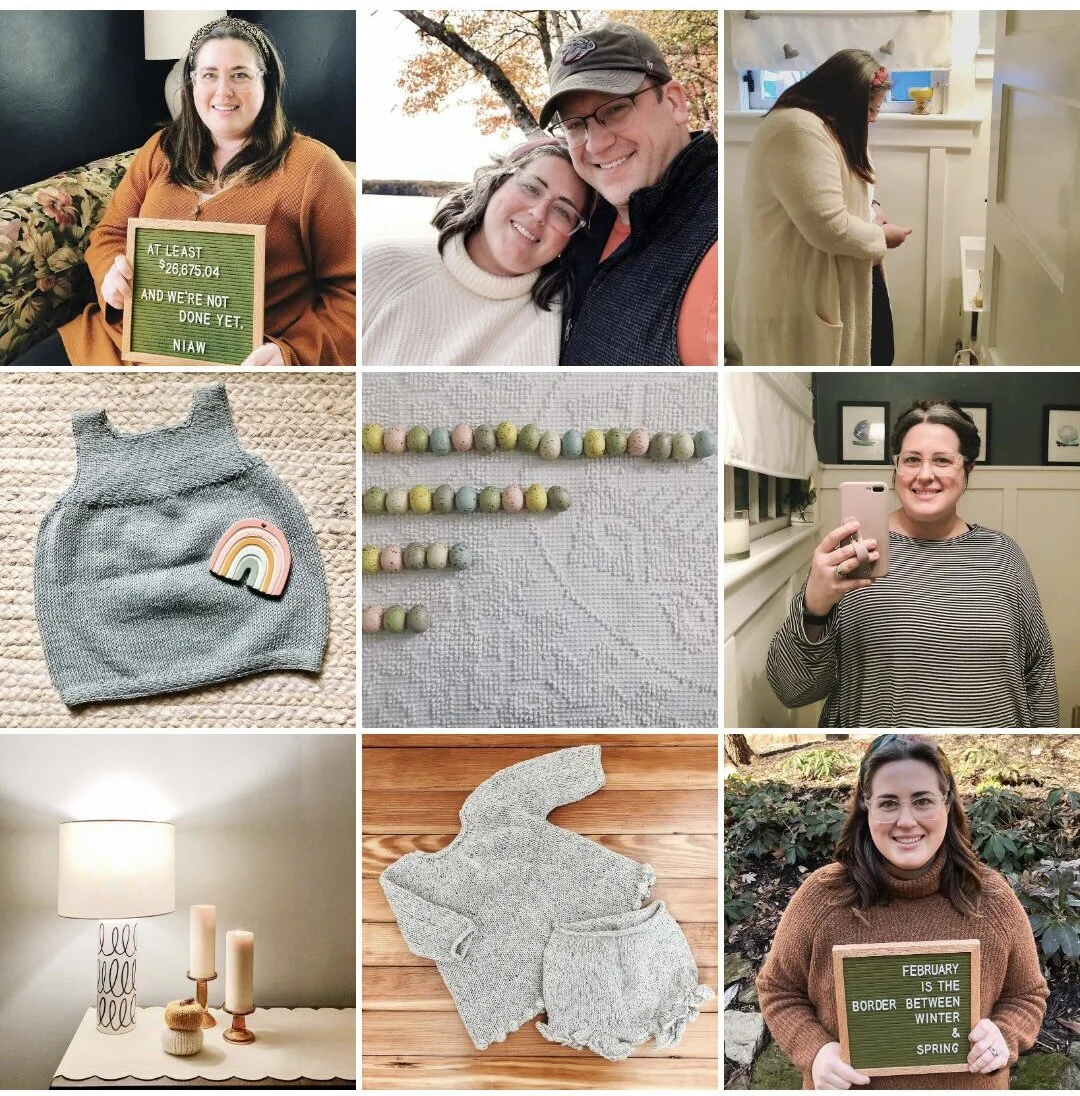Our Infertility Journey: Part Seven
/Infertility impacts approximately 15% of couples in America and is a result of abnormal functioning of the male or female reproductive systems. Because I have Polycystic Ovarian Syndrome (PCOS), I live with one of the most common causes of infertility in women.
To be clear, my goal with these posts is to be open. Since we began fertility treatments in 2017 I've done a lot of searching to find experiences and stories from women living with PCOS and/or going through fertility treatments, and so far I haven't come up with much. Because I want to hear about what other women are experiencing, I am sure that others out there feel the same. While I know this is my story, I hope that by sharing it openly I will help someone else through whatever they are experiencing.
one of the latest little baby outfits I’ve knitted!
If you read my June goals post last week, you’ll know that we completed a second IVF egg retrieval cycle earlier this month! When we wrapped up our first retrieval cycle in March (you can read all about it here!), completing a second retrieval cycle right away was not even on our mind. But now, having gone through it and knowing the results, we are glad we took that extra step!
If you remember from what I shared about our first cycle, we ended up with four embryos that were developed enough to be genetically tested. After we learned that two of those embryos were genetically normal, we scheduled a virtual appointment with our doctor to discuss his recommendations for next steps.
Why we completed a second retrieval cycle
As we discussed options for our next steps with our doctor, there were two that we had to consider - move forward with a frozen embryo transfer (FET) cycle, or complete another egg retrieval cycle to add a few more frozen embryos to our “bank”. While neither was the right or wrong choice, here’s why we ultimately decided to complete another egg retrieval cycle right away:
Nothing about IVF is guaranteed to work: As Kurt and I have talked about family planning, we have talked about hopefully having two or three children someday. But because nothing about IVF is actually guaranteed to work at any step of the process, only having two frozen embryos meant the chances of having to do another retrieval cycle at some point in building our family were high. Completing another retrieval cycle now would likely give us a larger cushion for when we did move forward with the next steps, in case we had further setbacks along the way.
My age and how that impacts egg quality: As a woman ages, her egg quality decreases. And because of my PCOS diagnosis, my egg quality already isn’t great. Taking advantage of another egg retrieval cycle now while I’m younger would likely help us increase the number of younger, higher quality embryos we have frozen, which also helps us increase our chances of success throughout this process of building our family.
Repeating the process sooner could yield even better results: While we were all very happy with the results of our first retrieval, my doctor suggested that because we had just finished a retrieval cycle, there was a chance my body could respond better a second time because it had essentially just learned what to do. Doing a second cycle so close to the first also would allow us to adjust my medication protocols more confidently in the hopes of stimulating even more follicle growth a second time around.
The differences between cycles one & two
With our decision made to complete a second egg retrieval cycle, we waited a couple more weeks until the office reopened for new IVF retrieval cycles to begin in the midst of the Covid-19 pandemic. In mid-May we were notified that IVF retrieval cycles could start again, and we were ready to go!
The biggest difference between the first and the second retrieval cycles was my medication protocol and how I responded to it. While the medications that we used in both cycles were the same, with the second cycle I started at double the dosage amount that I had started with during the first cycle. With these higher dosages we definitely saw a difference in my follicle counts and development, and I certainly felt a difference in how my body was responding!
I gave myself injections twice a day from May 22 until June 2 and had monitoring appointments on May 22, 27, 29, June 1, and June 2. Pretty quickly I started to feel bloated and sore in my midsection as my follicles and ovaries grew in size. By the end of my stimulation cycle my ovaries were close to the size of grapefruits - imagine feeling that in your midsection! Kurt administered the trigger shot this time around, and on the morning of June 4 we went for our second egg retrieval!
Those feelings of being bloated and uncomfortable continued through our retrieval on June 4 and developed into something called Ovarian Hyperstimulation Syndrome (OHSS). For about ten days following the retrieval I was really uncomfortable waiting for the extra fluid in my abdomen to dissipate and my ovaries to decrease in size. I had a lot of trouble sleeping this second cycle because of how uncomfortable I was both leading up to and following the retrieval procedure. But given the results of this second round, I’m happy to have been uncomfortable for a few days because it gave us the chance to see so much success from the process!
Cycle two results
I knew pretty quickly into this second cycle that I was responding much better than the first round. We tracked about 35 follicles - 20 on the right and 15 on the left - pretty consistently during my monitoring appointments, and knew that the majority of those were going to be of mature size by the time we got to the retrieval. Going from only expecting five or six eggs based on follicle development from our first round to seeing about six times that much growth was a bit overwhelming. But a lot about IVF is a numbers game, so I knew that having more follicles developing would help increase our chances of having a successful retrieval.
Just like with our first retrieval, following the procedure it was another few days of waiting as the embryologists check, fertilize, and monitor the eggs. Updates were given to us from the embryologist lab on Day 1, Day 3, Day 5, and Day 6. Here’s a breakdown of our numbers from this second round:
46 eggs were retrieved!
Of those 46 eggs, 38 of them were mature and were combined with Kurt’s sperm using ICSI.
We found out the day after the egg retrieval that of those 38 eggs that were combined with sperm, 34 of them fertilized. That is considered Day 1 for the embryos.
On Day 3, we learned that of those 34 embryos, 32 of them were growing right on schedule.
On Day 5, we learned that 7 embryos had made it to the blastocyst stage and were ready for biopsy, and another 12 embryos were potentially close behind. The remaining 13 embryos were discarded because they had stopped progressing.
On Day 6, we learned that 6 more of the embryos had made it to the blastocyst stage and were ready to be biopsied and frozen! The biopsied cells from those 13 embryos would be sent for genetic testing and the embryos would be frozen until we knew the results of that testing and could potentially move forward with a transfer. The remaining 6 embryos were discarded because they had stopped progressing.
Our next steps
Last week we received the results of our second round of genetic testing. Of the 13 embryos that we sent, 10 of them came back as genetically normal. So in total, we have 12 normal embryos sitting on ice! Almost a week later from receiving that news I still find myself thinking about that number and being a bit shocked. The chances that those embryos will provide us to build our family are so great, and we are so grateful to have had the support of our family to afford these two retrieval cycles.
So, up next is that FET! We are currently in the middle of completing a test called the Endometrial Receptivity Analysis (ERA), which will test the receptivity of my endometrial lining. During this test I take all of the same medications that I will take when we do a real FET. But instead of transferring one of our frozen embryos when I’m finished with the medications, instead I’ll undergo a quick biopsy of my endometrial lining. The results of that biopsy will help our doctor narrow down the best window of time to perform a transfer to maximize the chance for implantation and eventual pregnancy. It’s an optional test, but Kurt and I determined that we wanted to take this extra step in order to maximize that chance for implantation success. And because I’ve experienced miscarriage already along our treatment journey, taking the time to identify my ideal transfer window was important to us in the hopes of avoiding a failed transfer. Once the test is completed, we’ll be able to start the real FET protocol with my next menstrual cycle!
Over the weekend I realized how many milestones we’ve achieved since the beginning of 2020. We’ve been hoping to start this IVF process for so long, and it’s not lost on me how lucky we are to have the support network we do to keep us moving forward. I’m hopeful that by the end of 2020 we’re starting to check off a different set of milestones, this time ones associated with an actual pregnancy! Keep your fingers crossed for us, friends - we appreciate your good thoughts and prayers so much!
Mama friends - I also would love your insight in a quick survey linked below! Each time I share a photo of a baby clothing item that I’ve hand-knitted, I hear encouragement from a few of you to open an online shop. Well, I’m thinking about it more and more, and would love your insight! Click the button below to share your thoughts and help me realize this idea a bit further!














